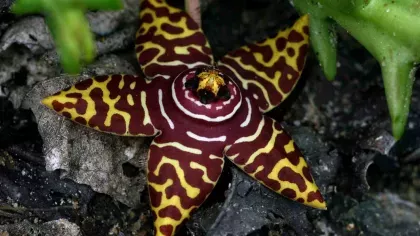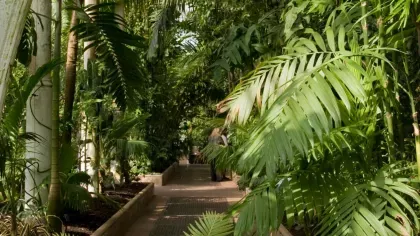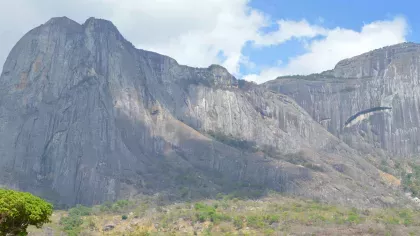Tropical Important Plant Areas (TIPAs) in Mozambique
Identifying and promoting the long-term conservation and sustainable management of Mozambique’s most important sites for plant diversity.

Mozambique is home to a wealth of plant and habitat diversity including 5900 known plant species of which over 330 species are only found within Mozambique.
Many of Mozambique’s wild plant species have a recognised socio-economic value while other species and habitats perform valuable ecosystem services including watershed protection. Survival of these valuable plant species and habitats is severely threatened by human activities such as timber extraction, mining and land clearance for agriculture and in many cases we are lacking readily available information on their distribution. There is an urgent need to identify the critical sites for plant conservation in Mozambique so that the limited resources available can be targeted to ensure the sustainable management and long-term survival of Mozambique’s plant and habitat diversity.
The assessment of Important Plant Areas (IPAs) in Mozambique offers a practical but rigorous means of identifying the priority areas for site-based conservation. IPAs are aligned to Target 5 of the Convention on Biological Diversity’s (CBD's) 'Global Strategy for Plant Conservation' and so offer an important step towards fulfilling national CBD targets.
Kew’s role in the project
Kew is working in collaboration with Mozambique’s Agricultural Research Institute (IIAM) and Eduardo Mondlane University to identify Important Plant Areas in Mozambique. The project builds on previous collaborative work in the Chimanimani mountains, Mount Gorongosa, Mount Namuli, Maputaland and the coastal dry forests of Cabo Delgado. Activities include fieldwork, herbarium research, IUCN red-listing, workshops and training.
Objectives
- Ensuring the long-term survival and sustainable use of Mozambique’s endemic, threatened and socio-economically important plant species through inclusion in Important Plant Areas with national and/or community protection.
- Raising public awareness of the global importance of Mozambique’s rare plant species and vegetation types and the key sites where they occur.
Project Leader
Project Manager
Team
- Online database of Mozambique’s Important Plant Areas and endemic, threatened and socio-economically important plants.
- Mozambique’s Important Plant Areas book, webpages and booklet for schools.
- Conservation and management recommendations for the identified IPAs and the priority species and habitats they support.
- Published list of Mozambique’s endemic and near-endemic plants.
- Updated Red List of the threatened plants of Mozambique.
- Publication of new plant species discoveries for Mozambique.
- Interactive map of Mozambique
The first two TIPAs for Mozambique – the Chimanimani Mountains and the Chimanimani Forest Zone (Maronga-Moribane) – were identified and assessed at a workshop of TIPAs partners and stakeholders in Maputo in February/March 2018. We also are making great progress with identifying plant species in most urgent need of protection in Mozambique – over 80 species were redlisted at this workshop.
- Instituto de Investigação Agrária de Moçambique (IIAM), Maputo, Mozambique
- Universidade Eduardo Mondlane, Maputo, Mozambique
- Micaia Foundation, Chimoio, Mozambique
- Plantlife International
Darbyshire, I., Timberlake, J., Osborne, J. et al. (2019)
The endemic plants of Mozambique: diversity and conservation status.
Phytokeys 136: 45 - 96.
Darbyshire, I., Anderson, S., Asatryan, A. et al. (2017)
Important Plant Areas: revised selection criteria for a global approach to plant conservation
Biodiversity & Conservation 26: 1767-1800
Timberlake, J., Darbyshire, I., Wursten, B. et al. (2016)
Chimanimani Mountains: Botany and Conservation. Report produced under CEPF Grant 63512
Royal Botanic Gardens, Kew, London. 95 pp
Müller, T., Mapaura, A., Wursten, B. et al. (2008 – published 2012)
Vegetation Survey of Mount Gorongosa. Occasional Publications in Biodiversity no. 23
Biodiversity Foundation for Africa, Bulawayo, Zimbabwe
Timberlake, J., Bayliss, J., Dowsett-Lemaire, F. et al. (2012)
Mt Mabu, Mozambique: Biodiversity and Conservation. Report produced under the Darwin Initiative Award 15/036
Royal Botanic Gardens, Kew, London. 94 pp
Timberlake, J., Dowsett-Lemaire, F., Bayliss, J., et al. (2009)
Mount Namuli, Mozambique: Biodiversity and Conservation. Report produced under the Darwin Initiative Award 15/036
Royal Botanic Gardens, Kew, London. 114 pp
The Jonathan and Jennifer Oppenheimer Foundation, Stephen Lansdown CBE and Margaret Lansdown.
Kew projects
Balancing conservation and livelihoods in the Chimanimani Forest belt, Mozambique
Kew Strategic Output
Tropical Important Plant Areas


